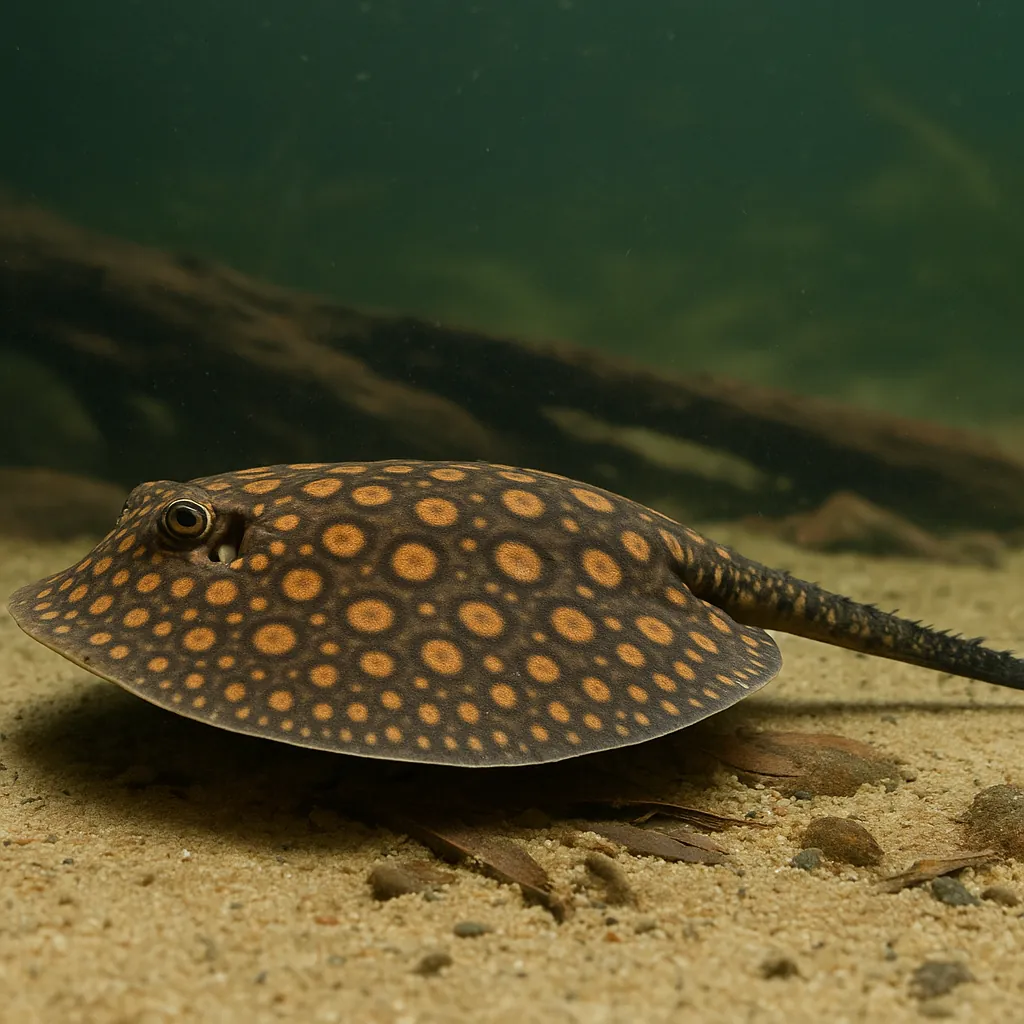
Ocellate river stingray
Introduction
The Ocellate River Stingray (Potamotrygon motoro), also known as the Motoro Stingray, is a captivating freshwater species native to South America. Renowned for its distinctive pattern of yellow-orange spots encircled by dark rings on a brownish body, this stingray adds a unique aesthetic to large aquariums. However, due to its substantial size and specific care requirements, it is best suited for experienced aquarists prepared to meet its needs.
What makes the Ocellate River Stingray appealing to aquarists?
Its striking appearance and intriguing behaviors make it a standout addition to large, well-maintained aquariums.
Is the Ocellate River Stingray suitable for beginner fishkeepers?
Due to its demanding care requirements and potential size, it is generally recommended for more experienced aquarists.
Care and Environment
Proper care for the Ocellate River Stingray involves meticulous attention to tank size, water parameters, filtration, and diet.
What is the minimum tank size for an Ocellate River Stingray?
A single adult requires a minimum tank size of 1,500 liters to accommodate its growth and swimming needs.
What are the ideal water parameters for this species?
Maintain a temperature between 24°C and 26°C, a pH of 6.0 to 7.5, and soft water conditions to replicate their natural habitat.
Effective filtration is crucial due to the stingray's sensitivity to water quality. A robust system capable of turning over the tank volume multiple times per hour is recommended. Subdued lighting and a soft, sandy substrate are ideal, as these stingrays often bury themselves. Decor should be minimal to maximize open swimming space.
Feeding should consist of high-quality, meaty foods such as bloodworms, shrimp, and fish fillets. Juveniles may require live foods initially but can be transitioned to frozen or prepared diets over time. Feed at least twice daily to meet their metabolic needs.
Are there specific challenges in keeping Ocellate River Stingrays?
Yes, they are sensitive to water quality fluctuations and require large tanks, making their care demanding and not suitable for all aquarists.
Origin and Habitat
Native to the freshwater systems of South America, the Ocellate River Stingray inhabits the basins of the Paraná-Paraguay, Orinoco, and Amazon Rivers. They prefer calm waters with sandy substrates, often burying themselves to ambush prey. These environments are typically rich in vegetation and experience seasonal variations, including flooding during the rainy season.
Where can Ocellate River Stingrays be found in the wild?
They are found in the freshwater rivers and streams of South America, particularly in the Amazon and Orinoco basins.
What type of environment do they prefer?
They favor calm waters with sandy bottoms, where they can bury themselves and remain concealed.
Temperament and Compatibility
Ocellate River Stingrays are generally peaceful but can be predatory towards smaller fish. They are best kept with similarly sized, non-aggressive species that occupy different areas of the tank, such as Silver Arowanas or large cichlids. Avoid housing them with small or bottom-dwelling fish that could be mistaken for prey.
Can Ocellate River Stingrays be kept with other fish?
Yes, but tank mates should be chosen carefully to avoid predation and ensure compatibility.
Are they aggressive towards other stingrays?
They can be territorial, so adequate space and monitoring are necessary when housing multiple stingrays together.
Interesting Facts
Ocellate River Stingrays possess a venomous spine on their tail, which they use for defense. In the wild, they are known to migrate within freshwater systems, a behavior termed potamodromous. Additionally, they give birth to live young, with litters ranging from 3 to 21 pups.
Do Ocellate River Stingrays lay eggs?
No, they are ovoviviparous, meaning they give birth to live young.
How do they defend themselves?
They have a venomous spine on their tail that can inflict painful wounds if threatened.
Sources
All information in this article has been gathered from the following reputable sources:
Overview
Recommended Tank Size 528.3 Gallons (for a pair) |
Minimum Group Size 1 |
Minimum Tank Volume 396.3 Gallons |
Maximum Adult Length 23.6 inches |
Average Adult Length 19.7 inches |
Shoaling (6+ required) No |
Preferred Water Type Freshwater, soft, acidic |
Temperature Range (°C) 24–26 |
pH Range 6.0–7.5 |
Water Hardness (dGH) 0–10 |
Typical Lifespan (years) 10 years |